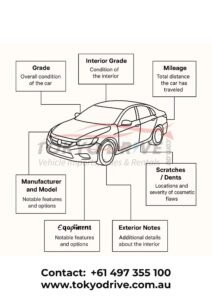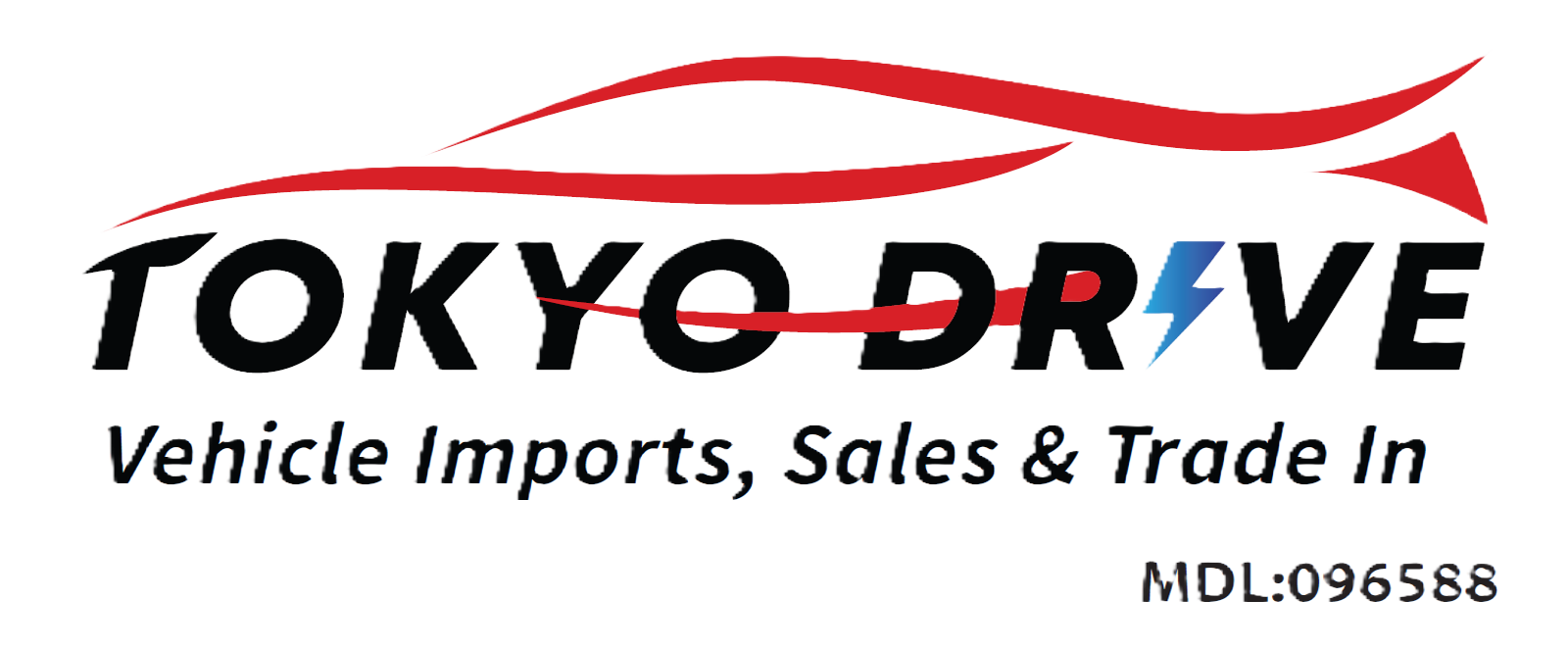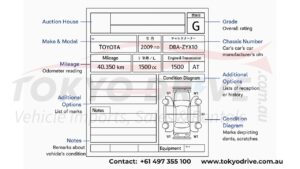Japanese car auctions can seem complex to newcomers, but once you understand how to read an auto auction sheet, it opens the door to a world of affordable, high-quality vehicles. At Tokyo Drive, we specialize in helping Australians import Japanese Domestic Market (JDM) cars, and one of the first things we teach our customers is how to interpret these essential documents.
In this blog, we’ll walk you through what an auto auction sheet is, what the common markings mean, and how you can confidently use it to assess the condition of a vehicle before bidding. By the end, you’ll be well on your way to becoming an auction sheet expert.
What Is a Japanese Auto Auction Sheet?
A Japanese auto auction sheet is an official document issued by the auction house that details the condition, specifications, and history of a car. It’s essentially a report card for the vehicle, allowing buyers to evaluate cars before placing a bid. The transparency and detail in these sheets are a major reason why Japanese auctions are so trusted worldwide.
Each auction sheet includes:
- Make and model
- Year of manufacture
- Mileage (in kilometers)
- Engine size
- Transmission type
- Chassis number
- Vehicle grade and condition
- Inspector’s notes (in Japanese)
- Interior and exterior condition ratings
- Diagram showing damages or repairs
Understanding these sections will help you avoid hidden issues and make an informed purchase.
Key Symbols and Terminology You’ll Find on the Sheet
Vehicle Grade
One of the first things you’ll notice is the grade. This is a quick summary of the overall vehicle condition:
- S: New (Usually under 10,000 km)
- 6: Like-new
- 5: Excellent condition
- 4.5: Very good
- 4: Good condition, minor wear
- 3.5: Fair, signs of aging or repairs
- 3 or below: Poor condition or accident-repaired
Understanding these numbers is key to choosing a high-quality car.
Interior and Exterior Grades
Separate from the overall grade, these grades focus on specific areas:
- A: Excellent
- B: Good
- C: Fair
- D/E: Poor or damage present
These grades help you assess if the car is cosmetically pleasing.
Damage Codes
You’ll also see abbreviations on the sheet like:
- A1-A3: Scratches
- U1-U3: Dents
- W1-W3: Waves or distortion
- XX: Replaced part
- X: Needs replacement
- P: Paint marks
Refer to the body diagram where these symbols are marked on specific parts of the vehicle.

How to Use the Sheet to Make Smart Buying Decisions
Now that you understand how to interpret the auction sheet, here are some practical tips for using it effectively:
1. Start with the Grade
If you’re looking for a clean, used import with minimal issues, target cars with an overall grade of 4 or higher.
2. Check Mileage
Mileage is listed in kilometers. A good benchmark is under 100,000 km for long-term reliability.
3. Review the Body Diagram
Use the damage codes and diagram to assess cosmetic and structural damage. Avoid cars with multiple XX markings.
4. Translate the Inspector’s Notes
These are usually written in Japanese. Use tools like Google Translate or rely on your dealer (like Tokyo Drive) for accurate interpretation.
5. Ask for Photos and Reports
Most auction listings include multiple high-quality images and inspection reports. Don’t just rely on the auction sheet—get the full picture.
Why Trust Tokyo Drive?
At Tokyo Drive, our mission is to make JDM car importing transparent and hassle-free. We provide complete translation and analysis of auction sheets, expert consultation, and access to the largest Japanese auction houses.
Whether you’re looking for a Nissan Skyline, Toyota Supra, or a daily commuter, we help you:
- Understand the auction sheet in detail
- Avoid poorly maintained or damaged cars
- Bid with confidence
- Handle all paperwork, compliance, and shipping to Australia
Conclusion
Understanding Japanese auto auction sheets is one of the most powerful tools you can have when importing a car. It allows you to make data-driven decisions, avoid costly mistakes, and ensure you’re getting value for your investment.
Let Tokyo Drive be your trusted partner in the process—we’re here to make your JDM dream car a reality.
Ready to explore? Check out our available inventory or get in touch today to start your import journey!



